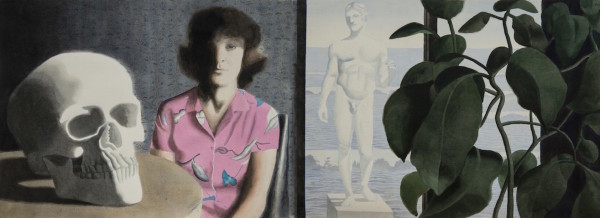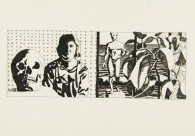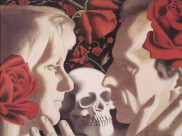To his friends, Robert was noted for his reticence and quiet disposition. However his “Seal Upon Thine Heart” paintings were based on an Elizabeth Smart novel noted for its dense outpouring of words and emotion. Smart referred to this as “The Lavishness of My Feelings.” Robert equated lavishness with the Baroque style. Though the figure in this image is rather expressionless, sitting like a woman waiting to have her passport picture taken, she wears a brightly colored, richly patterned blouse. Half her face is hidden in shadow and this shadow creates a feeling of mystery and reverie. This Baroque lighting device accompanies a Baroque theme, Mary Magdalene reflecting on her own mortality. This left side of the image mimics the sparse style of Baroque art, in which a “theatrical portrait” makes use of props, costumes and lighting effects to depict a historical or allegorical character.
By alluding to Mary Magdalene, Robert suggests the woman and central figure of his image cycle, is spiritually charged, yet somehow controversial, an unrepentant adulteress. The casual attitude of the figure is in ironic contrast to the more traditional depictions of Magdalene as a woman wringing her hands, clutching her breast and beseeching heaven to forgive her past mistakes. The right hand panel makes reference to classical Greek sculpture. The naked male torso may be a projection of the woman’s thoughts or daydreams. The use of classical statues in idealized landscapes is common in Baroque art. As so often in Robert’s images, a series of oppositions is introduced: death and life, interior and exterior, woman and man, human and statue, Christian and classical mythology, sitting and standing.




